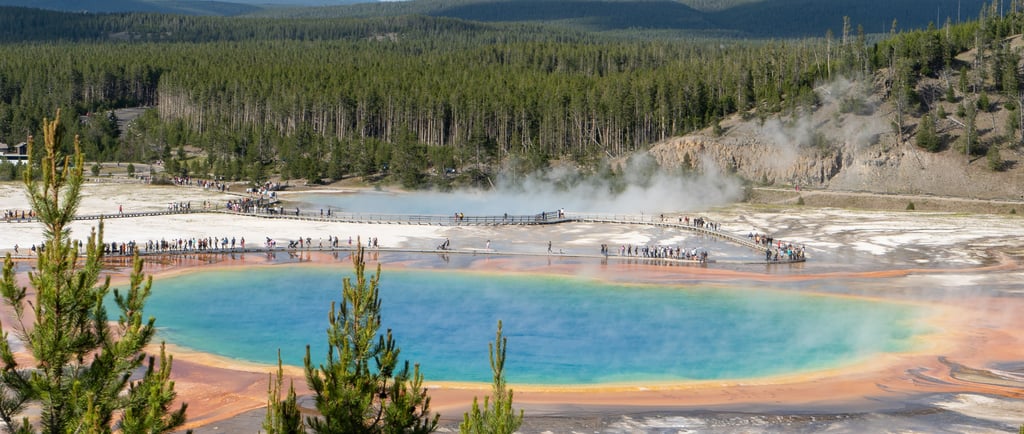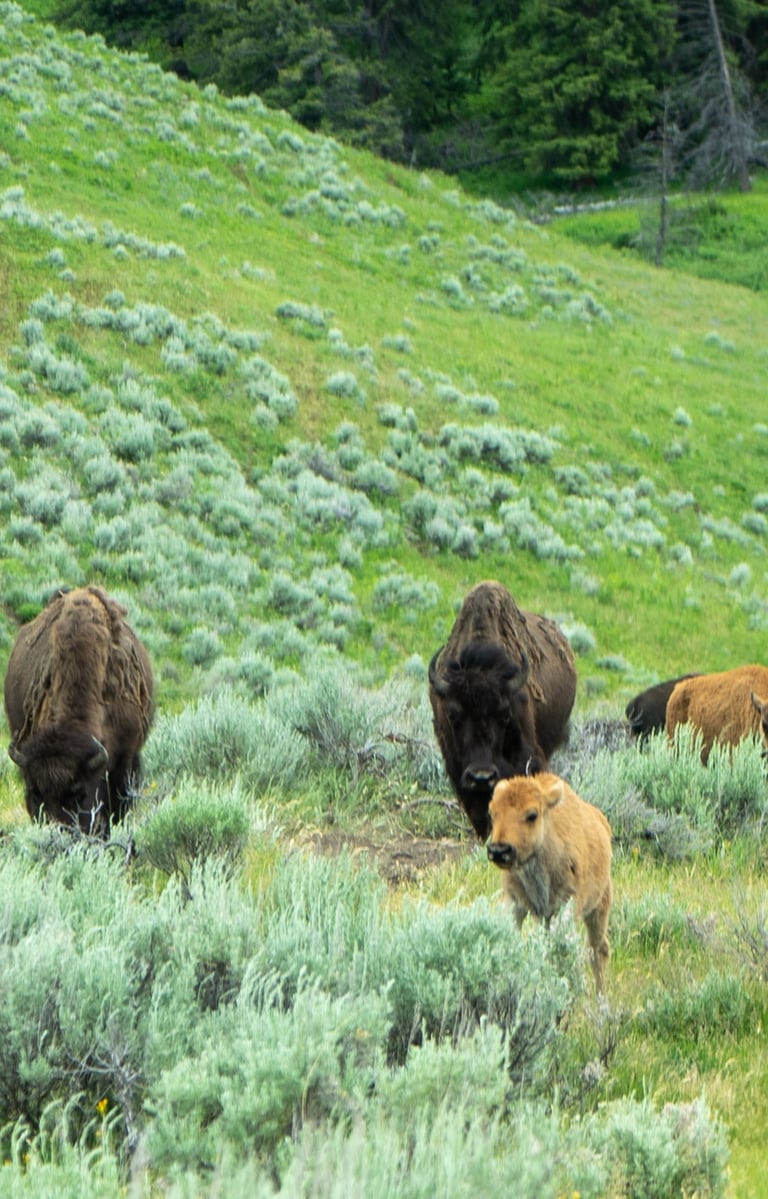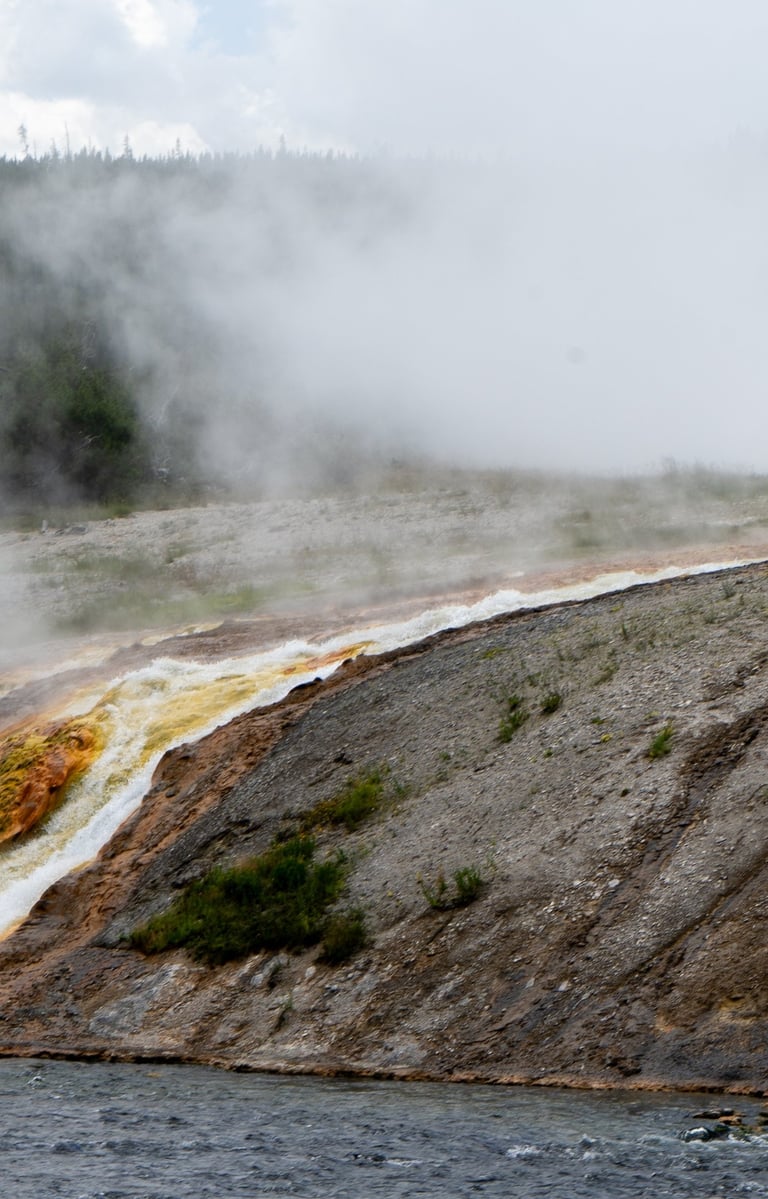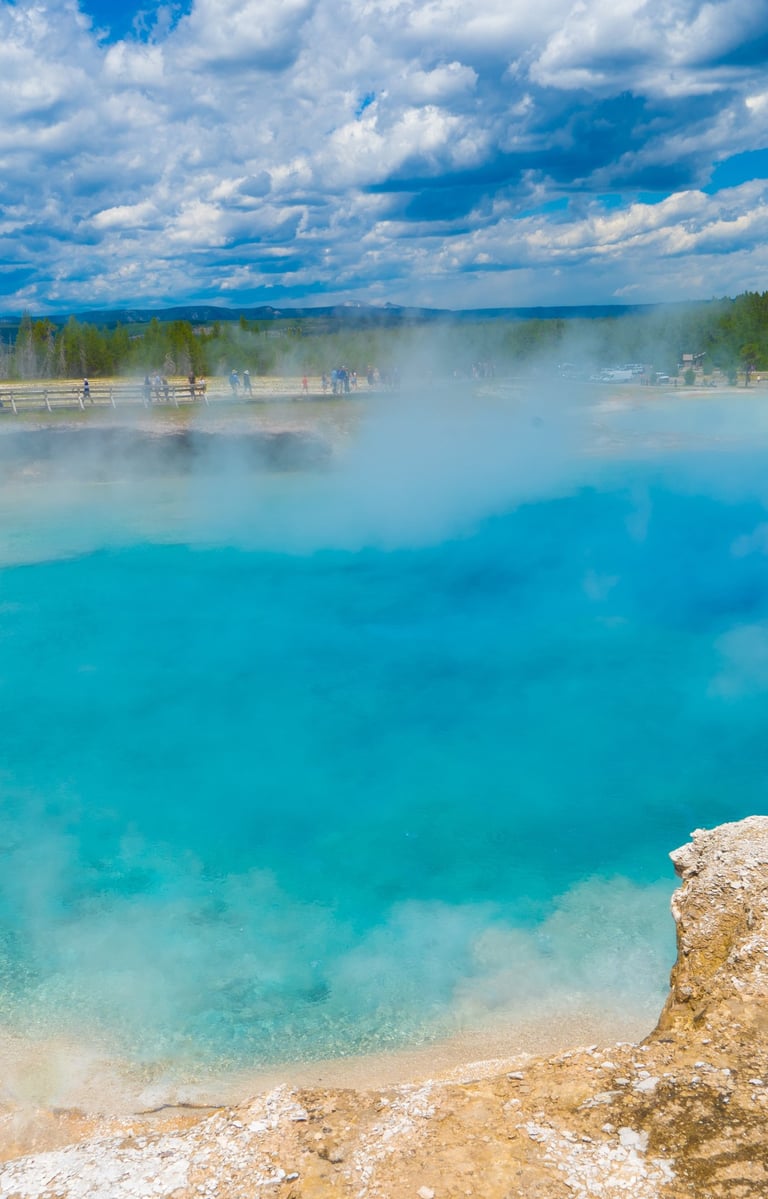Exploring Yellowstone: A Journey Towards Environmental Protection


Introduction to Yellowstone National Park
Yellowstone National Park, established in 1872, is recognized as the first national park in the United States and holds a prominent place in the global conservation movement. Situated primarily in the U.S. state of Wyoming, the park extends into Montana and Idaho, encompassing over 3,400 square miles of diverse terrains, including lakes, mountain ranges, and geothermal features. This remarkable geographical diversity contributes to its status as an ecological treasure, housing a wide array of ecosystems that support numerous species of flora and fauna.
The park is perhaps best known for its unique geothermal features, such as geysers and hot springs, with Old Faithful being one of the most famous. These geothermal phenomena are the result of volcanic activity beneath the surface, which also contributes to the park's rich geological history. Visitors to Yellowstone are treated to breathtaking landscapes that showcase the natural beauty and geological wonders, attracting millions of tourists each year. More than just a tourist destination, however, Yellowstone serves as an important natural laboratory for scientists studying biodiversity and ecological processes.
As a refuge for many species, including elk, bison, and grizzly bears, Yellowstone plays an essential role in biodiversity preservation. The park's varied habitats, from alpine meadows to dense forests, create an ideal environment for thousands of species, making it a crucial area for wildlife conservation efforts. The historical significance and ecological richness of Yellowstone National Park underscore the urgent need for environmental protection, as these natural systems are increasingly threatened by climate change, invasive species, and human encroachment. By understanding the importance of preserving Yellowstone, we can foster a greater appreciation for this iconic landscape, paving the way for more effective conservation strategies in the future.
The Importance of Environmental Protection in Yellowstone
Yellowstone National Park, established in 1872 as the first national park in the United States, is renowned for its stunning landscapes and diverse ecosystems. However, the environmental protection of this iconic location is increasingly significant due to various threats it faces today. Climate change, pollution, and habitat destruction pose serious risks to the park's biodiversity and natural beauty.
One of the foremost challenges impacting Yellowstone is climate change, which is manifesting through rising temperatures, altered precipitation patterns, and increased frequency of wildfires. These shifts disrupt the delicate balance of ecosystems, affecting both plant and animal species. For instance, warmer temperatures can lead to the decline of native species, while invasive species may thrive, further destabilizing the ecological equilibrium. As such, effective environmental protection measures are crucial in combating these adverse effects and preserving Yellowstone's unique habitats.
Pollution also poses a significant threat to Yellowstone's environment. Airborne pollutants, primarily from industrial sources and vehicular emissions, can lead to acid rain, which adversely impacts soil and water quality. Additionally, water pollution from agricultural run-off and human activities can disrupt aquatic ecosystems, endangering fish populations and other wildlife dependent on these habitats. Maintaining clean air and water is of paramount importance to ensure the health of Yellowstone's ecosystems.
Moreover, habitat destruction due to human incursion presents another layer of risk. Increased tourism without responsible management strategies can lead to trail erosion, wildlife disturbance, and the degradation of natural resources. Various environmental charities and organizations play a critical role in safeguarding Yellowstone's ecosystems. These entities work tirelessly to promote sustainable practices, facilitate conservation programs, and raise awareness regarding the importance of protecting the park's unique environment. Collaboration among governmental bodies, local communities, and conservationists is essential to ensure the continued preservation of these irreplaceable natural treasures.
Sustainable Practices for Visitors
When visiting Yellowstone National Park, it is imperative for guests to adopt sustainable practices that contribute positively to the environment. One key principle to abide by is the Leave No Trace philosophy, which encourages visitors to minimize their impact on natural surroundings. This involves planning ahead, traveling on durable surfaces, and disposing of waste properly. By following these guidelines, visitors can help preserve the beauty and integrity of the park for future generations.
Effective waste management is another essential aspect of sustainability in Yellowstone. Visitors should bring reusable containers, such as water bottles and lunch boxes, to limit the use of single-use plastics. Furthermore, it is crucial to responsibly dispose of any trash, recycling where possible, and utilizing designated waste disposal areas. Keeping the park clean not only enhances the experience for everyone but also plays a significant role in protecting wildlife habitats.
Interactions with wildlife present a unique challenge for sustainable visiting in Yellowstone. Observing animals from a safe distance is vital to minimize stress on the species and ensure personal safety. Engaging with wildlife, including feeding, is strictly prohibited, as it disrupts their natural behaviors and can lead to dangerous encounters. By respecting animals’ space, visitors help maintain the balance within the ecosystem.
Lastly, responsible photography practices should be a priority for those capturing the stunning imagery of Yellowstone. Using established trails and vantage points minimizes the risk of trampling fragile flora and fauna. Additionally, it is wise to avoid flash photography, particularly near wildlife, as it can startle animals and disrupt their natural behavior. By adhering to these sustainable practices, each visitor has the opportunity to contribute to the protection of Yellowstone's remarkable environment.
Volunteering Opportunities in Yellowstone
Yellowstone National Park, renowned for its stunning landscapes and diverse wildlife, offers a plethora of volunteering opportunities dedicated to the preservation of its natural beauty. Individuals and groups can significantly contribute to environmental conservation efforts within this iconic park. Various projects cater to different interests, skills, and time commitments, allowing volunteers to engage meaningfully with the park's ecosystem.
A popular volunteering initiative is the Yellowstone Volunteer Ambassador program, which allows participants to assist park visitors, enhance their experiences, and promote environmental stewardship. This role is crucial as it helps educate the public about the park’s ecological significance, thereby fostering a deeper respect for nature. Additionally, volunteers can partake in restoration projects aimed at revitalizing damaged habitats or removing invasive species that threaten the native flora and fauna.
For those interested in wildlife conservation, participating in monitoring programs provides an opportunity to engage directly with the park’s diverse animal populations. Volunteers may assist in tracking animal movements, collecting data, and contributing to research efforts that inform conservation strategies. This hands-on experience not only benefits the wildlife but also enriches the volunteer's understanding of ecological relationships within the park.
Getting involved in these programs is typically straightforward. Individuals can visit the official Yellowstone National Park website to explore available opportunities, application procedures, and necessary training. Most volunteer projects welcome seasonal help, and community groups are encouraged to organize larger events, such as park clean-up days or wildlife surveys.
The impact of volunteer efforts in Yellowstone cannot be overstated. By contributing time and skills, volunteers play a significant role in protecting the park’s environmental integrity and promoting its health for future generations. Whether through restoring habitats, educating visitors, or participating in research, every effort counts in the ongoing mission to safeguard this natural treasure.
Conservation Success Stories in Yellowstone
Yellowstone National Park stands as a testament to the power of conservation, with numerous success stories that demonstrate the positive impact of dedicated efforts. One of the most notable achievements is the recovery of the gray wolf population. In the mid-20th century, wolves were eradicated from the park, significantly disrupting the ecosystem. However, in 1995, a reintroduction program was initiated, allowing these apex predators to return to their natural habitat. The presence of wolves has since led to a healthier balance among herbivore populations, particularly the elk, and has revitalized the park’s vegetation, showcasing the crucial role predators play in ecosystem dynamics.
Another remarkable success story centers around the restoration of bison populations. Once nearing extinction due to overhunting and habitat loss, the bison now roam the park in thriving herds, thanks to effective management practices and habitat restoration efforts. This initiative not only serves to protect the bison as a species but also enhances biodiversity within the park, helping to maintain the integrity of Yellowstone’s ecosystems.
Moreover, the reintroduction of beavers is another significant step in habitat recovery. By rebuilding dam structures, beavers create wetlands that provide critical ecosystems for various species while improving water quality and mitigating flooding. Their presence symbolizes a return to natural processes that support biodiversity.
Engagement with visitors has also improved, with numerous educational programs designed to foster a connection with nature. Environmental charities play a vital role in supporting these initiatives. Through their efforts, funding and resources are allocated towards ongoing conservation projects, ensuring that these success stories continue to inspire and sustain the natural beauty of Yellowstone. Continued support for such organizations is essential in shaping the future of Yellowstone as a protected landscape that celebrates both its rich biodiversity and the importance of environmental stewardship.
Supporting Environmental Charities Focused on Yellowstone
Protecting the natural beauty of Yellowstone National Park requires collective effort, and individuals can play a significant role in supporting environmental charities that are dedicated to this purpose. One of the primary ways to offer support is through monetary donations. Many organizations operate with the objective of conserving the park's diverse ecosystems and providing educational programs for the public. Charities such as the Yellowstone Forever and the National Park Foundation accept donations, which are often used for critical projects, educational outreach, and conservation initiatives. Even small contributions can have meaningful impacts when pooled together for a shared cause.
Engaging in fundraising events is another effective approach to support Yellowstone-focused environmental charities. These events, which may range from charity runs and hikes to auctions and galas, not only raise necessary funds but also cultivate a sense of community among participants. By becoming an active participant or volunteer in these events, individuals can help spread awareness about the importance of preserving Yellowstone's unique landscapes and wildlife. Websites and social media platforms of these organizations often list upcoming events and ways to participate, making it easy for anyone to get involved.
Awareness campaigns are equally essential in garnering support for Yellowstone's environmental conservation efforts. Sharing information about the park's ecological significance on social media or through community groups can educate others on the issues facing this cherished natural landmark. Many charities provide resources, graphics, and information kits that can be shared to amplify the message. Furthermore, participating in community discussions and meetings about environmental protection helps to build a broader network of advocates dedicated to safeguarding Yellowstone for future generations.
By embracing these multifaceted opportunities—donations, fundraising events, and awareness campaigns—individuals can make a lasting impact on the future of Yellowstone National Park. Supporting charitable organizations committed to environmental protection is a vital step toward preserving the park's precious ecosystems and stunning landscapes.
Conclusion: The Role of Each Visitor in Protection Efforts
Yellowstone National Park, renowned for its natural beauty and diverse ecosystems, presents a unique opportunity for all visitors to engage actively in its preservation. As individuals traverse the stunning landscapes and witness the intricate balance of wildlife, it is crucial to acknowledge the collective responsibility each person bears in protecting this national treasure. From the moment one steps into the park, a commitment to conservation must be embraced, as every small action can have a significant impact on the environment.
Visitors can contribute to environmental protection in various ways, such as adhering to park regulations, staying on designated trails, and respecting wildlife. These actions help minimize human interference in delicate habitats and ensure that ecosystems remain intact. Furthermore, investing time in educational programs and participating in interpretive tours can deepen one's understanding of the ecological significance of Yellowstone, fostering a sense of stewardship that extends beyond the individual's visit.
Additionally, each visitor is encouraged to support conservation efforts financially or through volunteer initiatives. Numerous organizations work tirelessly to maintain Yellowstone’s natural beauty, and involvement in these efforts can create a lasting legacy. Donations, whether monetary or in-kind, play a crucial role in funding research and conservation projects aimed at sustaining the park's ecological integrity for future generations.
Ultimately, the goal is to cultivate a culture of responsibility among visitors, emphasizing that the wellbeing of Yellowstone is a shared aspiration. By recognizing the importance of personal actions and encouraging others to do the same, each visitor can help ensure that Yellowstone remains a vibrant environment for both wildlife and future generations to enjoy. Through these collective efforts, the vision of a protected and preserved Yellowstone can become a reality.








